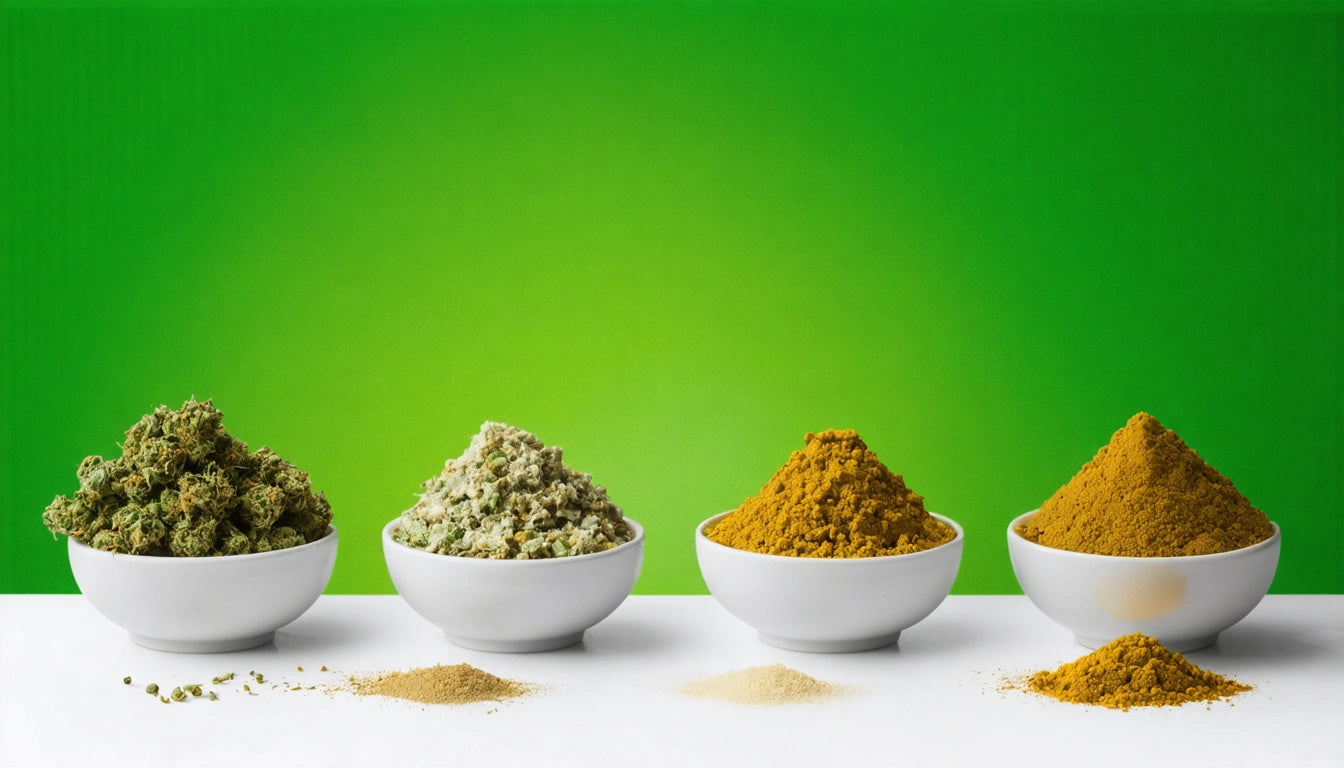Table of Contents
- Understanding Cannabis Concentrates: The Basics
- Badder Concentrate Profile: Creamy Consistency and Potency
- Rosin: Solventless Extraction with Premium Appeal
- Crumble Concentrate Characteristics: Dry Texture and Versatility
- Badder vs Rosin: Extraction Methods and Effects
- Crumble vs Badder: Texture, Stability and Usage Differences
- Storage and Preservation: Maintaining Concentrate Quality
- Consumption Methods and Recommendations for Different Concentrates
Comparing Cannabis Concentrates: Badder, Rosin, and Crumble
Cannabis concentrates have revolutionized consumption methods, offering higher potency and diverse textures that appeal to experienced consumers. Understanding the differences between badder, rosin, and crumble helps consumers make informed decisions based on their preferences for flavor, potency, and consumption methods. Each concentrate type offers unique characteristics that influence everything from shelf stability to terpene preservation.
Understanding Cannabis Concentrates: The Basics
Cannabis concentrates are extracted forms of cannabis that contain concentrated amounts of cannabinoids and terpenes. These products typically range from 60-90% THC, significantly higher than traditional flower, which averages 15-25%. Concentrates are created through various extraction methods that separate the plant's desirable compounds from the plant material.
The three main concentrate types we're comparing—badder, rosin, and crumble—differ primarily in their extraction methods, consistency, and appearance. These differences affect not only their physical properties but also their flavor profiles, potency, and ideal consumption methods.
Badder Concentrate Profile: Creamy Consistency and Potency
Badder (also called budder or batter) is known for its creamy, cake batter-like consistency. As detailed in this comparison of badder and similar concentrates, it's created using hydrocarbon solvents like butane or propane, followed by a whipping process that incorporates air and creates its signature texture.
Key Characteristics of Badder:
- Smooth, creamy texture that's easy to work with
- High terpene retention for flavorful dabs
- Typically ranges from golden to amber in color
- Usually contains 70-80% THC
Badder's popularity stems from its balanced properties—it's not too runny like sauces nor too solid like shatter, making it versatile for various consumption methods.
Rosin: Solventless Extraction with Premium Appeal
Rosin stands apart from badder and crumble primarily because it's produced without chemical solvents. Instead, it's created using heat and pressure to squeeze the resinous sap from cannabis flower or hash. This comprehensive comparison highlights how rosin's solventless nature makes it particularly appealing to health-conscious consumers.
Key Characteristics of Rosin:
- Solventless extraction method (no chemical residue)
- Full-spectrum effects with complete terpene profile
- Varies from sappy to butter-like consistency
- Typically ranges from 75-85% THC
- Often commands premium prices in the market
Rosin's popularity has surged among connoisseurs who prefer "clean" extracts and appreciate its artisanal production methods.
Crumble Concentrate Characteristics: Dry Texture and Versatility
Crumble is distinguished by its dry, crumbly texture that breaks apart easily. According to this detailed guide on crumble, it's produced using solvent extraction followed by a specific purging process that creates its distinctive consistency.
Key Characteristics of Crumble:
- Dry, honeycomb-like texture that easily breaks apart
- Typically light yellow to gold in color
- Lower moisture content than badder
- Usually contains 75-85% THC
- Longer shelf stability due to lower moisture content
Crumble's dry consistency makes it particularly easy to handle and portion, though it can be more challenging to work with on certain dabbing tools.
Highlight: When comparing badder vs rosin vs crumble, the extraction method significantly impacts not only texture but also the final chemical profile and effects of the concentrate.
Badder vs Rosin: Extraction Methods and Effects
The badder vs rosin comparison centers primarily on their production methods. Badder uses hydrocarbon solvents that must be purged from the final product, while rosin uses only heat and pressure. This fundamental difference affects several aspects:
Production Complexity:
Badder requires specialized equipment for safe solvent handling and purging, while rosin can be produced with simpler press equipment, even at home (though commercial operations use sophisticated presses).
Flavor Profiles:
Rosin typically preserves more of the plant's original terpene profile, resulting in a more robust flavor that closely resembles the source material. Badder still offers excellent flavor but may lose some of the more volatile compounds during the extraction process.
Effects and Potency:
Rosin often provides more "full-spectrum" effects since it retains more of the plant's original compound ratios. Badder may have slightly higher THC percentages but might lack some of the minor cannabinoids and terpenes that contribute to the entourage effect.
Crumble vs Badder: Texture, Stability and Usage Differences
When comparing crumble vs badder, the most noticeable difference is texture and moisture content. As explained in this crumble guide, these differences affect how they're used and stored:
Handling Properties:
Badder is sticky and malleable, making it easy to scoop but potentially messier. Crumble breaks apart easily and can be precisely portioned but may be more difficult to pick up with certain dab tools.
Shelf Stability:
Crumble typically has a longer shelf life due to its lower moisture content, which helps prevent degradation. Proper storage is still essential, and many concentrate enthusiasts use humidity control packs to maintain optimal conditions for their extracts, especially in varying climates.
Versatility in Use:
Badder works exceptionally well for dabbing and can be easily manipulated for other uses. Crumble excels for topping bowls or sprinkling into joints due to its ability to be broken into small pieces.
Storage and Preservation: Maintaining Concentrate Quality
Regardless of whether you choose badder, rosin, or crumble, proper storage is crucial for preserving potency and flavor. All concentrates benefit from:
- Airtight containers that prevent oxygen exposure
- Cool, dark storage locations away from direct light
- Stable temperature environments to prevent degradation
- Limited exposure to air during use
Silicone containers were once popular but have fallen out of favor as research showed they can absorb terpenes. Glass or PTFE containers are now preferred by most concentrate users.
Consumption Methods and Recommendations for Different Concentrates
Each concentrate type lends itself to specific consumption methods based on its consistency and properties:
For Badder:
Ideal for traditional dab rigs and e-nails due to its easy scooping. Works well in concentrate pens with chambers designed for thicker consistencies.
For Rosin:
Best consumed at lower temperatures (450-550 °F) to preserve its delicate terpene profile. Cold-start dabbing is particularly effective for rosin to avoid burning off valuable compounds.
For Crumble:
Versatile for both dabbing and as a bowl topper. Its dry consistency makes it perfect for sprinkling onto flower or rolling into joints for enhanced potency.
When selecting between these concentrates, consider not just the texture preference but also your primary consumption method and desired effects. Badder offers ease of use and balanced properties, rosin provides premium solventless quality, and crumble delivers versatility and stability. Each has earned its place in the concentrate market by catering to different consumer preferences and usage scenarios.











Leave a comment
All comments are moderated before being published.
This site is protected by hCaptcha and the hCaptcha Privacy Policy and Terms of Service apply.